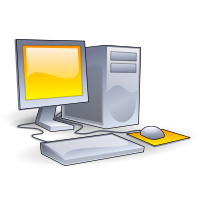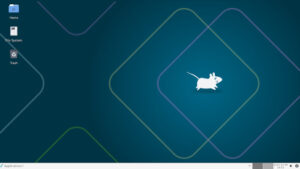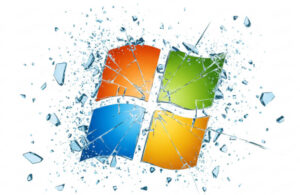We’re going to go off the beaten path a little bit here and start with Joe Walsh — the musician, not the politician — of all people.
In his latest album, Joe proclaims he’s an “Analog Man.” He’s an analog man in a digital world, and that’s something to which I can clearly relate. Here’s why: Until yesterday, all of my non-Macintosh hardware in the “Jungle Room” — I call it a lab because it’s filled with hardware, though I really don’t do anything in this room that remotely resembles research-and-development — is of 32-bit vintage.
 In comes a castoff ThinkPad T500 from a friend in Seattle and I’m now in the 64-bit club.
In comes a castoff ThinkPad T500 from a friend in Seattle and I’m now in the 64-bit club.
I get the advantages of the better/faster/stronger processor capacity, obviously: From Computers 101, say it with me, “The number of bits in a processor refers to the size of the data types that it handles as well as the size of its registry. A 64-bit processor is capable of storing 264 computational values, including memory addresses. This makes it capable of accessing over four billion times as much physical memory than a 32-bit processor.”
Yes, that will be on the final exam.
However, with the exception of the Mac which I rarely use — running Debian, thank you — the old desktop Dells are running at their maximum under the 32-bit threshold, and it’s been just fine that way. Even the Sun Ultra 10 — yep, Sun OS 5.9 (that’s Solaris 9, for those of you keeping score at home) — is still humming along as well.
You yawn while reaching for your cup of coffee, saying, “Hey, that’s great, Lar, but what does that have to do with anything?”
Glad you asked.
While it’s not really on anyone’s radar, and barely on mine, several communities are either openly discussing curtailing — some are already outright walking away from — a 32-bit version of their distro, opting instead to go 64-bit only. Understandably, more of today’s focus is on some of the more pressing issues of the FOSS day, like how systemd will end life as we know it while plunging the entire universe into its black hole of doom.
Hey, I know the drill: New users are going be using new hardware, and that’s going to be 64-bit. In order for Linux and FOSS to thrive, we have to stay current and be on the cutting edge. Keeping a 32-bit version around is a lot of work, taking valuable time and energy from moving forward.
That’s a debate for another time. Here’s why those who think 64-bit uber alles are being myopic. Putting aside for a moment that not everyone has the same resources to the newest hardware, there’s a lot of 32-bit capable hardware out there still running and still being used by people who may not be, for whatever reason, on the cutting edge of computerdom. I’m speaking not only of those of us in North American who, either by choice or forced by economic condition, to use older equipment. I’m also speaking of those in other countries who don’t have the same widely available resources as we do here in what we used to call the “first world.”
This is where distros like Debian — which, to its magnificent credit, seemingly makes so many versions of its distro that one will run on your electric toothbrush — gets it right. In addition, Fedora — which, Janus-like, is looking forward with ARM development while keeping a PowerPC version around that also benefits users of old Macs — is also on the right page. There are many others who are still doing the 32-bit/64-bit dance — and thank you for that — but there is an uncomfortably high number of distros which are walking away.
I have an appeal for the latter: Turn around.
So as I head out to work today at the ungodly hour of 5 in the morning to edit financial documents (I have to be at work while the stock market is stoking its machinery in New York), I’m packing the ThinkPad T500 and giving the ThinkPad T60 which has been with me constantly for the last 10 years a rest.
But I’m still at heart a 32-bit guy in a 64-bit world.








Agree with you, Larry. Clem seems not to be dropping 32-bit Linux Mint, so I’m still happy. Until the 64-bit stuff came out, I didn’t know that all my equipment was 32-bit. Then ReGlue gave me a ThinkPad for a perk a year or two ago and now it’s my daily driver and I’m using 64-bit like an addict.
But I still have a little Asus netbook for when I’m packing really light. I’m glad the latest 32-bit Mint is available and the instructions for non-PAE computers, whatever that means, are included.
Keep up the fight!
APOLOGIES FOR THE DELAY IN REPLYING, AND WITH THIS BEING IN CAPS, BUT IT TOOK A WHILE FOR LYNX TO DOWNLOAD THE PAGE OVER MY 110/75 BPS MODEM AND SEND IT TO THE TELEPRINTER.
I KNOW WHAT YOU MEAN ABOUT SUPPORT FOR TRIED AND TRUSTED TECHNOLOGIES. I GET VERY FRUSTRATED AT THIS CONSTANT “ATTENTION-SEEKING” DESIRE TO HAVE NEW TECHNOLOGIES LIKE HTML E-MAIL OR FANCY GRAPHICAL DISPLAYS LIKE CURSES ETC.
IF IT CAN’T BE DONE IN 12-BITS IT’S NOT WORTH DOING.
I can’t imagine Debian dropping 32-bit Intel any time soon. And back when I had a Mac G4, it ran Debian better than anything else.
I’m still running a 1999-era Compaq Armada 7770dmt with a Pentium II MMX at 233 MHz, 144 MB of RAM and a 3 GB hard drive with Debian Squeeze and the new LTS support.
I am torn on this subject because as much as I love certain technologies, there comes a time when you HAVE to let it go in order to be productive and viable in the world today. Case & Point: I used to LOVE the Polaroid instant camera, I had like five of them in my lifetime, but that technology has long since passed, who wants to stand around waiting for a picture (that’s not even sharp and crisp!) to develop when you can just snap 5 – 10 shots with your smart phone? As much as I still used 32-bit OS’es at home on older hardware, eventually it won’t be efficient to keep on running it. That’s not to say that some companies won’t have a need for 32-bit software/hardware/OS’es, but the numbers will diminish eventually. (How many people here know of anyone who still uses a Polaroid instant camera?) And when that time comes?…you don’t want to just be entering the 64-bit market, you’re best bet would be to get familiar with it now, maybe shop around for “replacements” so that when the time comes that you’re unable to find replacement repair parts for your machine, you can have an idea of what you want/need to get your work done. I use a few 32-bit OS’es still on older hardware (the grey “putty” colored Dell Optiplexes from the 1999 / 2000 era!…that is DEFINITELY on it’s last legs!!) But I also have a superfast machine running a 64-bit system..so I’m kind of “one-foot-in-one-foot-out” right now..but eventually that old “clay box” will give up the ghost and at least I’ll be ready to transition all my data without missing a beat!
My daily work consists in migrating existing Windows networks to Linux here in South France, and more often than not, I have to deal with obsolete hardware. This is the main reason I’m using Slackware almost exclusively. Try to install a modern Linux server distribution on a Dell Poweredge 1300, you’ll see what I mean. Pentium-III 500 MHz, 110 MB RAM, 3 x 9 GB SCSI hard disks. Runs like a charm, while all the big players choked on it. My Xfce-based desktop even runs fine on an antique Panasonic Toughbook with a Pentium-M processor and 512 MB RAM.
Uncle Larry, did you not say “Choice is good”?
Okay, some distros choose not to have a 32 bit
version. That’s cool, the future will tell if
it was a smart decision.
Most of us buy on price and maybe 32 bits is all
our plastic will handle. My new (refurbished)
Lenovo X220 is in the pipe now but I just ordered
a new graphics card for the old, old like Larry,
Dell desktop.
I think the 32 bit crowd is safe for at least 20 years.
I still use 32 bit distros on most of my newer machines, including a Dell XPS 12, because 32 bit applications occupy half the RAM of a 64 bit distro, therefore doubling my available RAM. This may up my CPU cycles, but most processors in the last 6 years are still quite fast. It’ll be sad to see 32 bit disappear…
Also users may also have older machines and newer machines as well. Having the ability to have an up to date and secure operating system on an old desktop would be really nice if for example you dropped your laptop or the hard drive died. If you have around a 5 year update cycle for 2 machines and stagger updates between a laptop and desktop than 1 is getting around 10 years old before you udpdate. If you cut users off on their old boxes aren’t they incentived to try something else they may like better and may end up switching distros.
It’s a lot of work maintaining a distro for multiple architectures and a lot of smaller distros likely don’t have the manpower, so there’s nothing wrong with them dropping 32-bit support if it isn’t where they want to spend their energy.
Eventually it will get to the point where the 32-bit hardware just isn’t worth dealing with…How long until a Raspberry Pi type platform outperforms any 32-bit intel legacy hardware left in the world?
Raspberry Pi A+ is $20.
I should add that: Yes, I am aware the Pi is 32-bit, but ARM is a different beast than 32-bit Intel, which is pretty much a dinosaur.
Even if your machine has less than 4G you should be running in 64 bits. Reason is because the original X86 is register starved and in 64 bits it gets eight much needed additional registers. From distant memories I benchmarked audio-compression as 30% faster when in 64 bits mode.
The only reason for running in 32 bits is when you have a memoery-constrained machine (1G or less nowadays). That is because 64 bit prohgrams are larger and they could end causing swapping.
Now, if Fords Model Ts required special gas would you require every gas station in the whole USA keeping pumps just for the half a dozen Ford Model Ts in the whole country that are still running? Resources are not infinite, you see?
Well, same thing applies to Linux distributions. At one point it makes no sense to maintain 32 bit versions.
@Microlinux: You are hors-sujet. There is no question of running 64 bits on a 32 bits only CPU like the Pentium III. For the Slackware part I am happily running Fedora 20 64 bits on a 750 Megs machine. Only minimal swapping and easier to administer and install than Slackware. Problem is far less Fedora vs Slackware than KDE/Gnome vs XFCE or similar desktop..
You do realize though that your old 1998 vintage Sun Ultra 10 is in fact running at full 64 bit right ?
The UltraSPARC cpu from 1995 was the first SPARC full 64 bit CPU, followed by the UltraSPARCII and UltraSPARCIIi (in the Ultra 5/10/60) workstations. The ‘i’ was for integrating PCI bus in stead of the old SBus and also contained IDE/ATA disks in stead of SCSI disks.
At some point 32-bit will be phased out, just as 16-bit was. The question is: how to do it with a balance between resources of maintaining 32-bit vs. inconvenience for users in 32-bit world. One way would be to create a special Extended Support 32-bit Kernel that can receive bugs/security fixes for a long time; but any new Kernels are built only for 64-bit. Thus if you have legacy 32-bit hardware you still get security fixes; but for the new hardware/bleeding edge you don’t waste resources on 32-bit Kernels.
I can certainly sympathise with people who have of hardware that only supports 32-bit Linux distributions and would much rather hang on to that hardware and continue to use it, especially when it does a good job for them.
Personally, I think there is still a good selection of distributions that will allow the running of 32-bit versions for some time so with luck that will hopefully be good enough for those people who want to continue to use 32-bit versions.
In my case, like many people on this list I suspect, I have a foot in both camps. On one hand I have a 10-year-old Dell laptop that I pressed into service as a server when the screen died on me and that is 32-bit only, but runs Centos 5 quite happily and I will leave it that way until it either dies or the operating system is no longer supported.
On the other hand, I have a less than one year old HP Ultra book that acts as my day to day Linux machine, running 64-bit Linux Mint (KDE edition).
I even have a Bubba server with 256 MB of RAM, running an older version of Debian Linux, running on 32-bit PPC processor. So it’s a bit of a mixture. All my desktop hardware is 64-bit though.
“In addition, Fedora — which, Janus-like, is looking forward with ARM development while keeping a PowerPC version around that also benefits users of old Macs”
Thanks for the praise, but in fact the current PPC work in Fedora is mostly focused on PPC64:
https://fedoraproject.org/wiki/Architectures/PowerPC
“Only 64bit machines (Power5 or newer) are supported, but we still provide 32bit packages. The last Fedora release with 32bit boot images was Fedora 17. Although it might be possible to install a 32bit F17 release and then update with the latest packages, this is not supported by the Fedora PPC developers anymore. Interested developers might also be able to create their own 32bit boot images for the latest Fedora release with pungi but this is also not supported by the Fedora PPC developers.”
I am the one always looking at what’s next , so waiting for 128bit computing, but i wish they skip it for something higher .
I’m glad Walter pointed out the fact that your Ultra 10 is a 64-bit machine. In fact, you can even run Solaris 10 (albeit maybe not after a certain patch level). Furthermore, it just goes to show how far behind x86 arch. was until AMD pushed AMD64; and thank goodness they did!